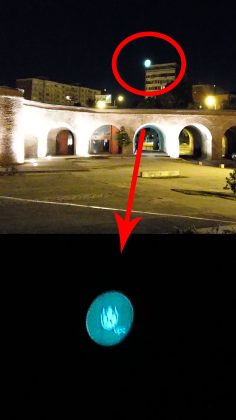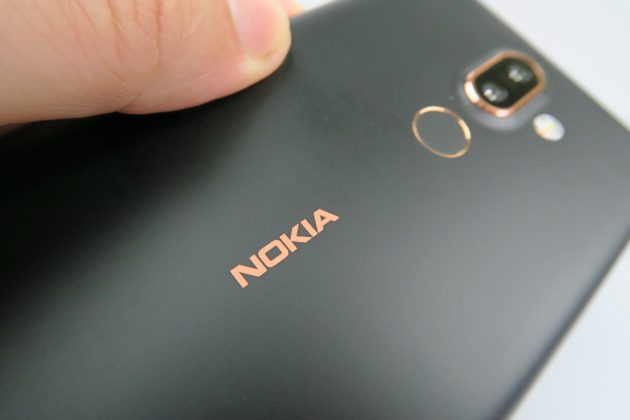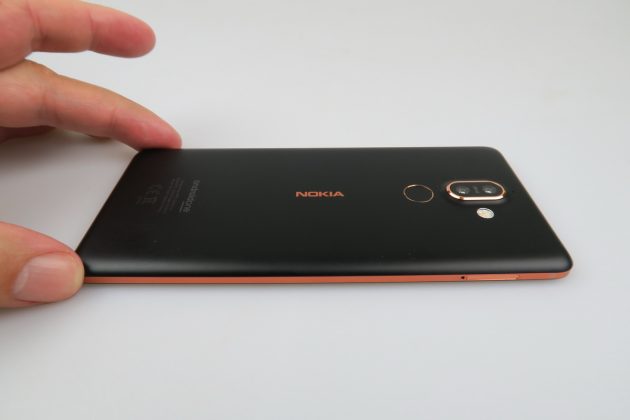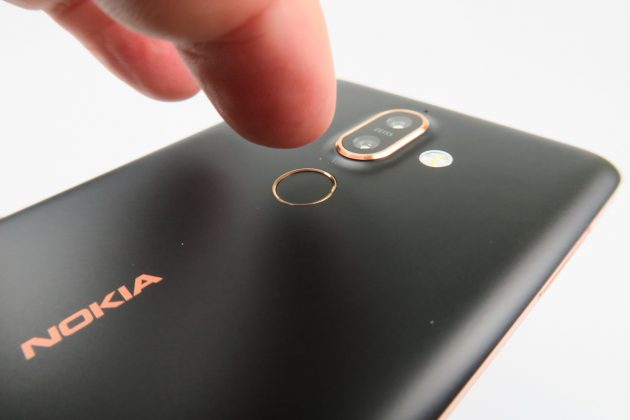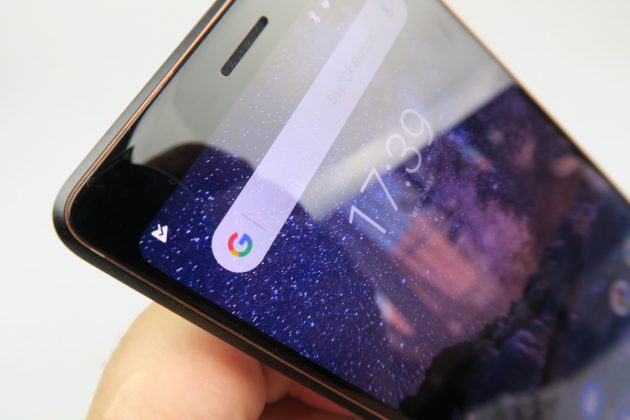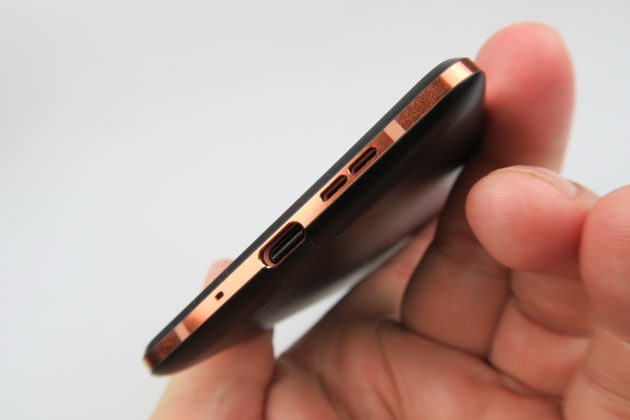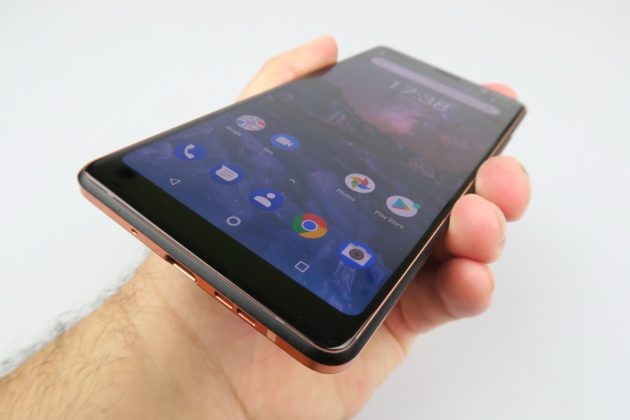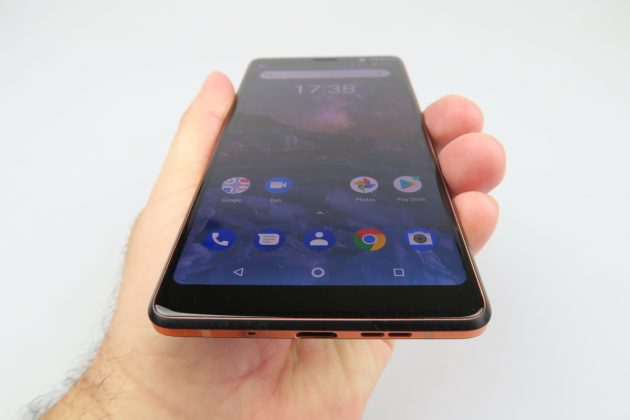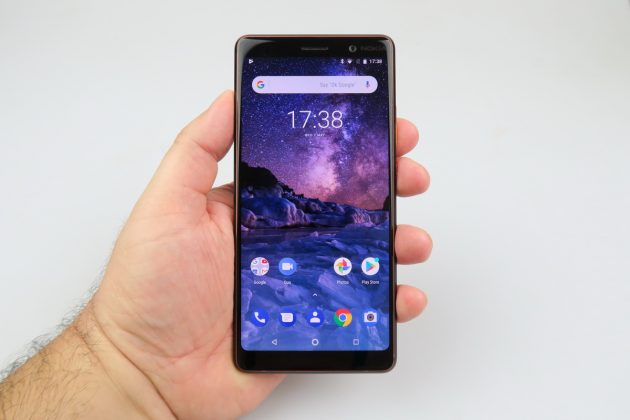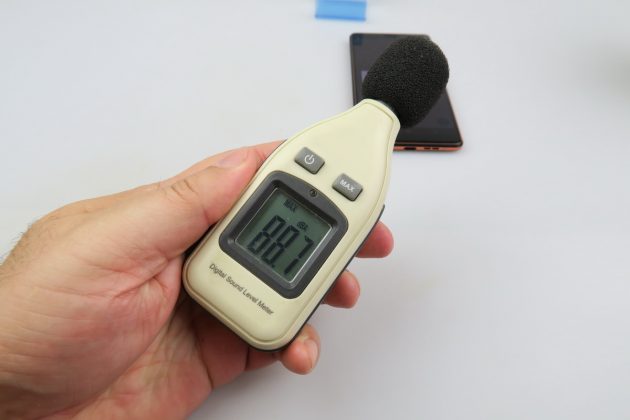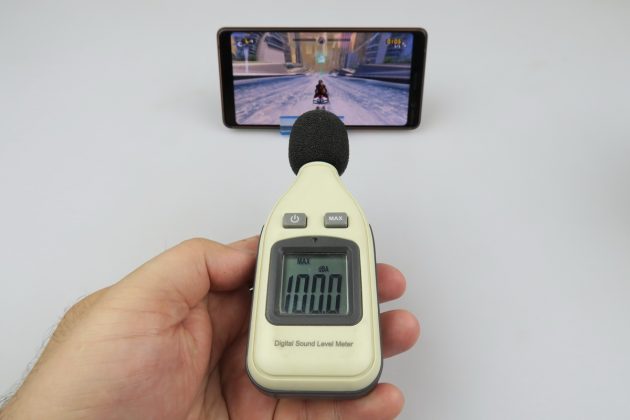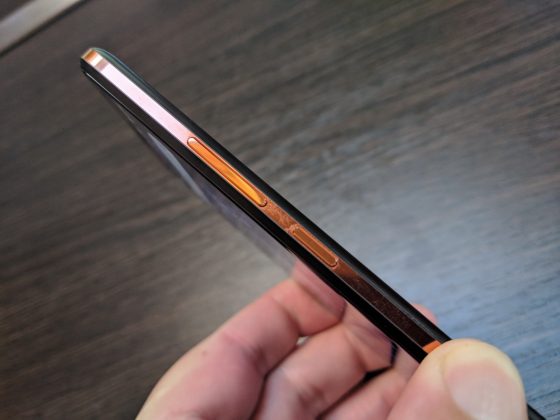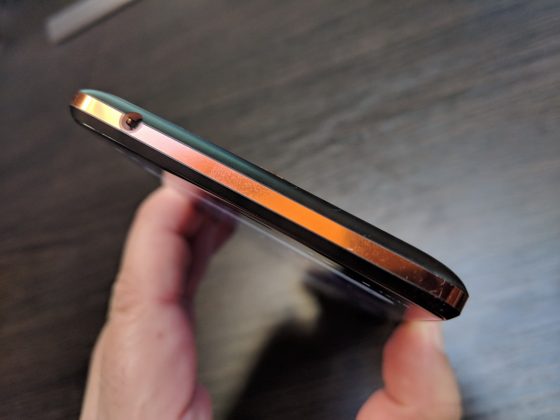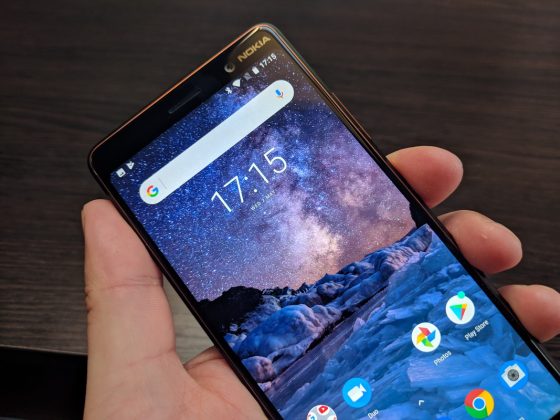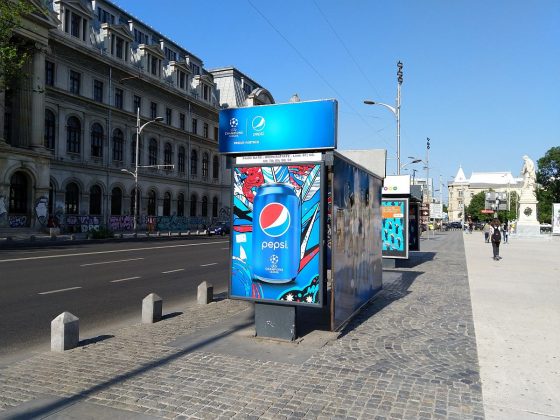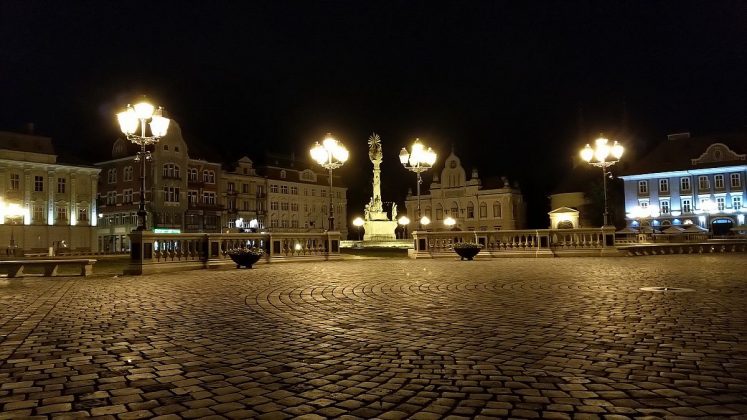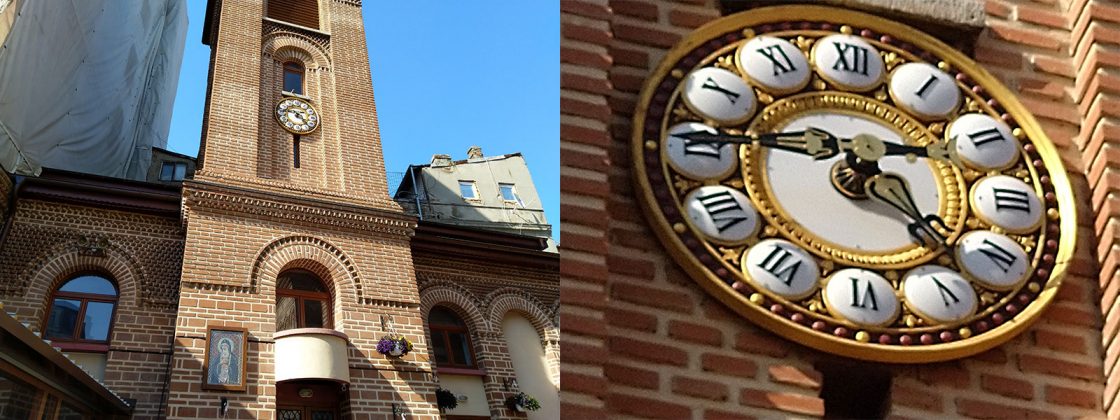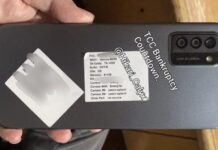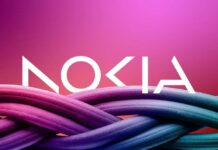Nokia 7 Plus is the latest in the series of midrange Android phones we’ve played with this year. I know exactly what its rivals are: ASUS ZenFone 5, Xperia XA2 Ultra, Motorola Moto X4 and Samsung Galaxy A8 (2018). It debuted at MWC 2018, with 4 other Nokia phones and it’s probably the best looking of the bunch. It’s got those copper accents making it extra sexy and it’s available in black or white. The price is around $350.
The device is a 6 inch high midranger part of the Android One initiative and it comes with a dual camera with Zeiss optics. It’s the first Nokia phone with 18:9 aspect and it runs a clear Android.

Design
It debuted this Spring and it’s got a smooth soft touch back. There’s something of a ceramic feel here. It does draw a bit of grease, if you’ve got your hand in the KFC bucket often.

Nokia made the phone out of a solid block of aluminum Series 6000 (well, Foxconn made it actually) and it’s got a sturdy and elegant build. This smartphone provides a great grip and it’s very long, so one hand use may not be very comfy. The buttons provide nice feedback and I’m totally loving the copper accents. The handset has diamond cut edges (2.75 mm thick) and no visible antenna lines.
Nokia 7 Plus measures 7.99 mm in thickness, or 9.55 mm if you also take into account the camera. It weighs 183 grams, which is quite big, considering there are many 160 gram 6.2 inchers out there. The build is premium, the design is sexy, but the device is not exactly easy to wield, being so long.

Display
Nokia 7 Plus packs a 6 inch IPS LCD display with a Full HD+ resolution and 18:9 aspect. The resolution is actually 2160 x 1080 pixels, typical nowadays and we are promised 1500:1 contrast ratio, with narrow bezels. There’s also Gorilla Glass 3 protection and the screen is both laminated and polarized. The viewing experience highlighted the rounded corners and I found the brightness to be OK, but not record breaking.

There’s not that much immersivity here, compared to a Galaxy A8. Colors are vivid and nice, view angles are wide, but the contrast was modest. Pixels have an RGB Stripes setup and the luxmeter showed us a value of 436 LUX, which is basically the low minimum of the midrange screen brightness value. It may beat a Huawei Mate 8 and Moto X4, as well as the HTC U11, but it scores below the Xperia XA2 and Galaxy S5 even.
Settings are rather stock: brightness, Night Light, Adaptive Brightness, font size, display size and Ambient Display. It’s an OK display, but I’ve seen better on dozens of devices.
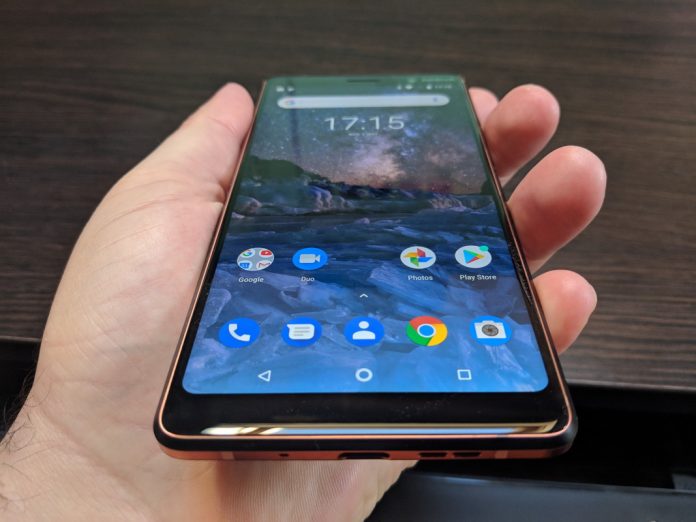
Hardware
This smartphone is packed with specs that are satisfying even for specs junkies. There’s the Snapdragon 660 CPU, 4 GB of RAM, so basically the same specs as the ASUS ZenFone 4. It’s got an Adreno 517 GPU, 64 GB of storage, of which 15.2 GB are being used, the rest is free. The microSD card slot on board is actually the second SIM slot, so we’re dealing with a hybrid slot here.
I didn’t experience any lag or trouble and the experience was rather fluid. Games ran fine, like the horror title Granny or Riptide GP Renegade. No stutter, no freeze, no lag. We also did some tests in benchmarks, such as AnTuTu 6, where we beat the Huawei Mate 8 and Galaxy A8 (2018), which is great. Still, we couldn’t surpass the Huawei P9 Plus and iPhone SE.

In AnTuTu 7 we beat the HTC U11 Life, Xperia XA2 and Moto X4, but scored below the Huawei P20 Pro. In GeekBench 4 Multi Core I actually got a surprise, as we placed on the 19th spot all time, beating the iPhone 7 Plus and Huawei P10 Plus, but scoring below the Nokia 8 and Huawei P10. Slingshot 3.0 showed us that the device can also handle gaming well, because we beat the Moto X4 and OnePlus 2, but scored below the LG G6 and Moto Z.
Benchmarks are great, as they place us at a 2016 flagship level and beating many midrange 2018 phones. Temperature was also dandy and fine, as we scored 36.6 degrees Celsius in GFXBench and 39.4 degrees in Riptide, so there’s no overheating.

Battery
Many 6+ inchers phones don’t impress in the battery area. Just look at the LG G7 and its 3000 mAh battery. The Nokia 7 Plus is OK in that regard, sporting a 3800 mAh battery, that on paper provides 2 days of usage. 30 minutes of charging means a 50% juice up, on paper too. We also did a video playback test and achieved 14 hours and 13 minutes, which is great and superior to the Samsung Galaxy A8 (2018) or the Galaxy S7 or the Huawei Mate 9. Still, there are better phablets out there: Xperia XA2 Ultra and Xiaomi Redmi 5 Plus to name just two.

In PCMark we scored 10 hours and 48 minutes, which is solid, I mean better than Galaxy S8 solid. There are some other heavy hitters past this model, like the Xiaomi Mi 6 and Xiaomi Redmi 4. Charging requires 1 hour and 58 minutes, which is not bad, either. It beats the iPhone SE and LG Q6 for sure. As usual, we like to charge the device in steps, so after 5 minutes we got to 8% and 15 minutes we were at 22%.
In 30 minutes we were at 39% and after 1 hour at 73%. Settings include Battery Saver, Adaptive Brightness, Background Activity Cleaner and everything felt tip top magoo in my view.

Audio/Multimedia
Nokia 7 Plus has 3 microphones, which serve it greatly, as you’ll find out later on. It’s got a singular speaker, placed at the bottom and luckily it’s not easy to cover with the hand by mistake. We used Google Play Music as the default music player and the equalizer brings 5 custom channels, genre settings, Bass Boost, Surround Sound and reverb. Typical options, I’d say.
The listening experience was satisfying and the speaker was loud, had OK clarity, not a bad bass and no vibration or distortion was present. I loved the way the guitar comes through, but overall, at top volume there were times when the speaker felt like too much. There’s no FM radio here, as far as I can see. The bundled headphones tend to tangle a lot and I also found a defect: the headphone connector doesn’t go all the way into the jack, which makes it prone to being torn from it.

The noise cancelling was very good and the headphones are comfy, have good volume and bass. Too bad for the plug, but it may just be the fault of our test unit. We also did a decibelmeter test and with an acoustic sample we hit 88.7 dBA at the front and back, which means we beat the HTC U11 Life, LG G5 and iPhone 8. Still we scored below the Xperia L1 and Nokia 3.
In Riptide GP Renegade we scored 100 dBA, which is pretty great and superior to the Huawei Mate 10 Pro, as well as the HTC U11, but inferior to the Nokia 8 and Xperia XA2 Ultra. Things are solid all around, but not stereo.
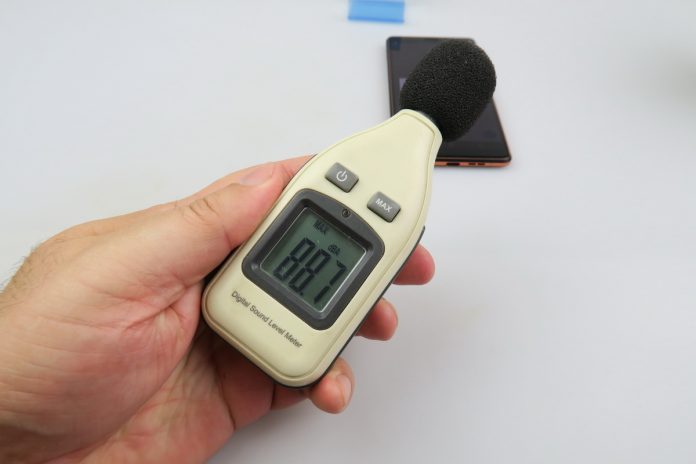
Camera
Nokia 7 Plus features a dual back camera, with a 12 MP and 13 MP sensor and Zeiss optics. It’s a version that was derived from the Nokia 8 cameras, from what I know. The 12 MP shooter has 1.4 micron pixels and F/1.75 aperture, while the 13 MP shooter has 1 micron pixels and F/2.6 aperture. There’s no OIS here, just EIS, in case you were wondering.

There’s a dual tone flash here, 2X optical zoom (which is something that the ASUS ZenFone 5 doesn’t have). Upfront we’ve got a 16 MP selfie shooter with Zeiss optics. The camera app starts up fast and the speed of the picture taking and zoom were spot on. Focusing was a bit sluggish, if I’m being honest. The exposure change was also sluggish. 2X zoom is instant and when it comes to camera functionality there’s Picture in Picture, dual capture (front and back camera at the same time), Panorama, Live Bokeh and a Pro Mode.

The latter lets you tweak white balance, ISO, exposure, shutter and focus. This device also shoots 4K video, with a very nice audio surround. You can actually choose to record audio with surround, back or front. Now let’s leave technicalities behind and get to the gallery. HDR was very bright, details were OK, but slightly inferior to the Xperias, the XA2 for example. It’s the megapixel count, I guess…

I loved the 2X zoom, which is quite high in details and even more surprising were the 4X, 5X and so forth in zoom. You can easily spot the tree leaves in the distance. As a paradox the device struggles with closeups, taking a few attempts to really pull them off properly. I loved the leaf texture, flower texture and in general the closeups I took.

The HDR fixes some of the weird blue hue of the bell we photographed. The colors were calibrated OK in my book and the green hue is superior to the Huawei P20 Pro, I’d say. Zoom was superb, just look at the church tower clock. Amazing! I loved the reds, the yellows, the clarity. There are also some drawbacks, like the very soft and burnt background in selfies sometimes.
The Bokeh capture was hugely poor and Bokeh was very hard to pull off. The device kept advising me to take one or two steps back to focus properly, which is kind of weird for Bokeh. Too close, it falls. Too far, it fails. Basically, the extra second camera is useless and Bokeh, when performed doesn’t totally surround the subject with blur in a proper way.

Things were less burnt than expected, for a very sunny day. The Panorama was excellent, at 12.800 x 2080 pixels and back to the selfies, I felt that the skin texture was poor, but the facial details were OK. However, the face is a bit too white in my book. It’s only when I moved further from the shady areas and got into the sunny part that the face became clear.
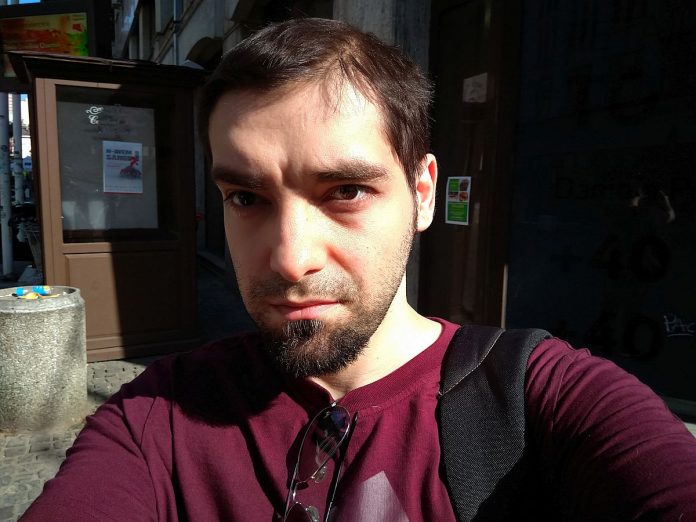
My advice? Get rid of the Face Beauty options, if you want better results. Overall, the selfies were OK, the good ones compensating the bad ones. In spite of that I feel that Sony Xperia XA2s did a better job and I’m saying that in spite of having some weirdly focused shots with the Xperia XA2 Ultra. Drawing a conclusion, I’d say that the Nokia 7 Plus camera is equal to the Moto X4 one, as well as the Galaxy A8 (2018) one. Bokeh is useless, selfies and closeup need work.
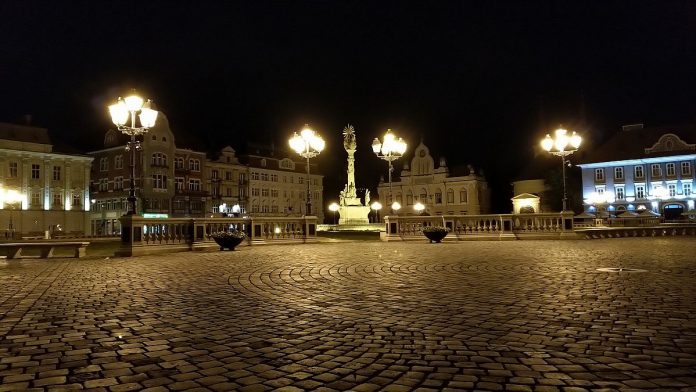
Selfies aren’t constant, but otherwise, things are perfect: clarity, colors, huge zoom details. I’d also say that the camera can fight the ZenFone 4 and even the ZenFone 5. In low light conditions the word you’re looking for is pragmatism. Ever since the LG Nexus 5X I haven’t seen such pragmatism. Clarity was excellent and the zoom was so good, that it was the first time I actually figured out what the logo on a tall building I usually photograph was.
Things are a bit darker than most phones and the street halos and lights were excellent. There’s no yellow, no blue hue, no oddity, nothing. It’s the equal of the Moto X4 and Galaxy A8 (2018) and it’s better than the Xperia XA2 ultra and the Moto X4. It’s got to be one of the least yellow midrange phone capture I’ve seen so far, so thumbs up.
On the video front, there’s MP4 Full HD action, at 30 FPS and 20 Mbps, while the 4K capture is done at 43 Mbps. Remember the promise of surround with crazy cool microphones? It’s real! The microphones here are amazing and offer real surround when filming. It handles the win, it catches voices like a boss, music too, so it’s fantastic for concerts and festivals.
I loved the lighting and colors of the videos, focus was spot on and when filming when walking the stabilization was nice. EIS is doing fine here, as fine as an iPhone 6S, I’d say. The 4K clip was crisp, but also a bit shaky. One of the things I’ll remember the most about this phone is the hue of blue it catches when filming. I also love the zoom quality, showing it’s no accident that we zoomed in so fine in photos.
The front camera filming was also nice looking, albeit with some focus loss. I’d put it on par with the Xperia XA2, which I called a pretty nice vlogger tool. Things get a bit too vivid and exposed at the end, but overall they’re OK. This has got to be one of the top 3 filming phones of 2018, in the midrange area at least. Even if there’s an Xperia, a Moto or ASUS on the market, Nokia still rocks.
We move to the night time video capture, where we met with motion blur, flickering, shakiness, grain and a pretty OK mic. The pan was done slowly and every motion you make triggers a flicker. I found that there were some extra reflections, that have no reason being there. At least there’s no extra yellow or other strange hues, which Sony have had trouble with over the past years.
Street light halos are big, though, with the Nokia 7 Plus. Even though I loved the camera overall, low light filming is just OK, not a champ.
Browser and Input
We also tested the browser and input, making use of Chrome, which loads up pages fast and has OK benchmarks. The keyboard is stock, well spaced and there’s also Swype here.

Connectivity
Nokia 7 Plus is fully featured in the connectivity area, with dual SIM card slots, of the nano SIM variety, 4G LTE Category 6, Bluetooth 5.0 and WiFi a/b/g/n/ac, NFC, GPS, AGPS, Glonass, BDS and USB Type-C. 3 microphones with OZO tech explain the crazy good video capture we did. The calls were loud and clear and noise cancelling was great. I really, really love the mics.

We also did a SpeedTest, achieving 93.2 Mbps in 4G download and 62.6 Mbps in upload. In WiFi testing we got to 225 Mbps in download and 25.2 Mbps in upload. Everything’s excellent by today’s standards.
OS, UI, apps
Nokia 7 Plus scores points in the OS and UI area as well, thanks to the fact it runs Android 8.1.0 Oreo with everything stock. There are notification dots, snooze for notifications and menus that come out of icons once you keep them pressed. There’s the Google Feed with the leftmost homescreen reserved to it. It holds the news, the weather, planes leaving soon, basically the keys of the universe.

A swipe up triggers the app drawer, once again a stock move. The dropdown section includes notifications and quick settings, all stock with two panes in the mix. Keeping the homescreen pressed lets you access the wallpapers, widgets an dHome settings. Once again, all vanilla, all pure Android and the promise of fast updates to Android P, Q maybe as well.
Everything is fluid, snappy and makes sense. We also tackled the fingerprint scanner, placed at the back. It takes 8 steps to set up and the unlock happens very fast, with a mere touch. There’s also Smart Lock, which offers unlocking via voice match, on body detection, trusted places and trusted devices. Apps are stock, there’s just 26 of them and everything is… stock, you guessed it.

There’s Calculator, Calendar, Drive, Duo, Files, Gmail, Maps and YouTube. Nokia/Google also took care of the accessibility, for people with impairments. There’s Talk Back, Magnification, Color Correction, Color Inversion, Large Mouse Cursor and Captions, as well as High Contrast.
And now it’s time for the verdict.
Conclusion
Here are the Pros:
- sexy and unique design
- Ok screen
- solid benchmarks and performance
- great battery
- clean and latest OS
- loud speaker
- very good camera
- excellent colors and details
- fantastic zoom in videos and photos
- superb mic
And the Cons:
- a bit too long
- poor Bokeh
- long time to focus in closeups
- so so contrast
- weird headphone connector
- selfies aren’t constant
- low light videos aren’t on par with the others
Nokia 7 Plus is the best midrange phone of the year 2018 so far. It’s got the best filming and microphone in my book, a fantastic battery and lovely copper accents. It has a clean software that puts it on par with Pixel phones and a brilliant microphone, as well as video/photo capture. The simple fact that it can rival the iPhone 7 Plus in areas like performance, zoom, filming is stunning.
It’s got the perfect OS if you really want an Android phone and takes some risks with the copper accents and formats. I think Nokia has a winner here. You can get it here.

